Study on Ecosystem Service Values of Urban Green Space Systems in Suzhou City Based on the Extreme Gradient Boosting Geographically Weighted Regression Method: Spatiotemporal Changes, Driving Factors, and Influencing Mechanisms
Abstract
1. Introduction
2. Research Materials and Study Methods
2.1. Study Area
2.2. Data Sources
2.3. Land Use Classification Procession Based on the Random Forest Algorithm
3. Research Method
3.1. The Calculation of Supporting and Regulating ESV Based on the inVEST Model
- (1)
- Habitat quality
- (2)
- Annual water yield
- (3)
- Carbon storage
- (4)
- Sediment delivery ratio
- (5)
- Nutrient delivery ratio
3.2. Entropy Weight Method
3.3. Feature Importance Calculation Based on the XGBoost Algorithm
3.4. Principal Component Analysis
3.5. GWR Method
3.6. Overall Research Process
- (1)
- Data collection and pre-processing: Collecting remote sensing images and driving factor data, and then applying the RF algorithm to compute the LULC maps for 2010 to 2020.
- (2)
- The computation of LULC maps: Land use classification processes using the random forest algorithm based on remote sensing images from Landsat-7 surface reflectance data.
- (3)
- Screening driving factors: Based on the feature importance results from the XGBoost algorithm, weak explanatory factors are removed, and strong ones are retained. The remaining factors are then subjected to PCA for dimensionality reduction, transforming the original correlated factors into three principal components (PCs) with linear independence.
- (4)
- Computing the total value of ecosystem services: Using the inVEST model to compute six ecosystem service value (ESV) indicators, assign weights to each indicator through EWM, and then calculate the total value and its spatial distribution for the period of 2010–2020.
- (5)
- Exploring the influencing mechanism: Using the principal components as independent variables and the total ESV as the dependent variable, GWR is applied to determine the spatial and temporal variations in the regression coefficients. The overall research framework is shown in Figure 6.
4. Result Analysis
4.1. Entropy Weight Method Weight Distribution and Total Value of ESV Calculation Results
4.2. Entropy Weight Method and ESV Calculation
4.3. Results of the XGBoost Algorithm
4.4. GWR Fitting Results
5. Discussion
5.1. Air Temperature and Aridity’s Influencing Mechanism on Ecosystem Services
5.2. Elevation and Landscape Pattern Influencing Mechanism on Ecosystem Services
5.3. Slope and NPP’s Influencing Mechanism on Ecosystem Services
5.4. UGSS Planning Optimization Based on the Analysis
- (1)
- Enhance Ecological Protection and Restoration: To address the uneven distribution of ecosystem services, Suzhou should enhance ecological protection and restoration. For high-density urban cores (like the Xiangcheng, central Zhangjiagang, northern Kunshan, central Changshu, and central Wujiang Districts), targeted vegetation enhancements should be implemented by developing pocket parks (minimum size: 0.5 ha) and urban forests (≥30% native tree cover) in areas with limited green space access (within a <500 m radius from residential zones), prioritizing native species with high carbon sequestration and pollution absorption. This approach aligns with the success of aquatic plant restoration, such as at Ziwei Cultural Park in Suzhou, where native species improved water quality from Grade V to III [69].
- (2)
- Improve Green Space Connectivity and Diversity: For suburban agricultural areas (like the northern Changshu, eastern Taicang, and southern Wujiang Districts), green corridors should be established (with a minimum width of 100 m) to connect fragmented high-quality habitat landscapes and increase diversity while integrating diverse vegetation layers (tree canopy, shrubs, ground cover) to enhance biodiversity. These measures will help connect fragmented green spaces, creating a network that boosts the overall value of ecosystem services. This approach has been successfully verified in Yancheng, Jiangsu Province, where it enhanced ecological connectivity by 20%.
- (3)
- Strengthen Ecological Barriers and Hydrological Regulation: In urban built-up areas, permeable surfaces should be increased, and impervious surface expansion should be limited to <25% in new developments. In areas of industrial concentration, pollution buffers should be implemented, and 500 m green buffers should be established around high-pollution industries. Through these measures, the diffusion of pollutants around industrial and high-density urban areas can be reduced [70].
- (4)
- Ecological Restoration and Adaptive Land Use Planning: Soil remediation should be implemented in degraded areas, increasing multifunctional parks in old urban and industrial areas, which can improve water quality. At the same time, soil can be remediated using plants and microorganisms, particularly by planting pollution-tolerant species (such as legumes) [71], which can absorb heavy metals and pollutants, promote the degradation of harmful substances, increase biodiversity, and provide recreational spaces for residents.
- (5)
- Additionally, establishing an ecological monitoring system to track soil quality, water quality, and vegetation growth in real time helps assess the effectiveness of restoration efforts. By using GIS and remote sensing technologies, continuous monitoring of urban green space changes allows for the evaluation of the impact of different land uses on ecological restoration and the optimization of strategies based on data.
5.5. Limitations and Prospects
6. Conclusions
Author Contributions
Funding
Data Availability Statement
Conflicts of Interest
References
- Yang, J.; Guan, Y.; Xia, J.C.; Jin, C.; Li, X. Spatiotemporal variation characteristics of green space ecosystem service value at urban fringes: A case study on Ganjingzi District in Dalian, China. Sci. Total Environ. 2018, 639, 1453–1461. [Google Scholar] [CrossRef] [PubMed]
- Pinto, L.V.; Inácio, M.; Ferreira CS, S.; Ferreira, A.D.; Pereira, P. Ecosystem services and well-being dimensions related to urban green spaces–A systematic review. Sustain. Cities Soc. 2022, 85, 104072. [Google Scholar] [CrossRef]
- Xu, H.; Paerl, H.W.; Zhu, G.; Qin, B.; Hall, N.S.; Zhu, M. Long-term nutrient trends and harmful cyanobacterial bloom potential in hypertrophic Lake Taihu, China. Hydrobiologia 2017, 787, 229–242. [Google Scholar] [CrossRef]
- Zhang, J.; Zhang, J. Countermeasures to Control NPS Pollution in Headwaters of Taihu Lake Basin. In Forestry Measures for Ecologically Controlling Non-Point Source Pollution in Taihu Lake Watershed, China; Springer: Dordrecht, The Netherlands, 2016; pp. 43–54. [Google Scholar]
- Guo, G.H.; Wu, F.C.; He, H.P.; Zhang, R.Q.; Li, H.X. Screening level ecological risk assessment for synthetic musks in surface water of Lake Taihu, China. Stoch. Environ. Res. Risk Assess. 2013, 27, 111–119. [Google Scholar] [CrossRef]
- Pernice, R. Verticality and Conflicting Identities in the Contemporary Chinese City: The Urban Development of Suzhou Industrial Park. J. Chin. Archit. Urban. 2021, 3, 1026. [Google Scholar] [CrossRef]
- Fang, C.; Chen, C.; Zhao, M.; LeGates, R. Integrating urban-rural development (IURD) through governance programmes in China’s Megacities: The Suzhou model. In New Urban Agenda in Asia-Pacific: Governance for Sustainable and Inclusive Cities; Springer: Singapore, 2020; pp. 39–64. [Google Scholar]
- He, L.; Xie, Z.; Wu, H.; Liu, Z.; Zheng, B.; Wan, W. Exploring the interrelations and driving factors among typical ecosystem services in the Yangtze river economic Belt, China. J. Environ. Manag. 2024, 351, 119794. [Google Scholar] [CrossRef]
- Wang, H.; Liu, G.; Li, Z.; Zhang, L.; Wang, Z. Processes and driving forces for changing vegetation ecosystem services: Insights from the Shaanxi Province of China. Ecol. Indic. 2020, 112, 106105. [Google Scholar] [CrossRef]
- Wang, X.; Wu, J.; Liu, Y.; Hai, X.; Shanguan, Z.; Deng, L. Driving factors of ecosystem services and their spatiotemporal change assessment based on land use types in the Loess Plateau. J. Environ. Manag. 2022, 311, 114835. [Google Scholar] [CrossRef]
- Lyu, R.; Clarke, K.C.; Zhang, J.; Feng, J.; Jia, X.; Li, J. Spatial correlations among ecosystem services and their socio-ecological driving factors: A case study in the city belt along the Yellow River in Ningxia, China. Appl. Geogr. 2019, 108, 64–73. [Google Scholar] [CrossRef]
- Liu, W.; Zhan, J.; Zhao, F.; Wang, C.; Zhang, F.; Teng, Y.; Chu, X.; Kumi, M.A. Spatio-temporal variations of ecosystem services and their drivers in the Pearl River Delta, China. J. Clean. Prod. 2022, 337, 130466. [Google Scholar] [CrossRef]
- Gao, J.; Zuo, L. Revealing ecosystem services relationships and their driving factors for five basins of Beijing. J. Geogr. Sci. 2021, 31, 111–129. [Google Scholar] [CrossRef]
- Geng, T.W.; Chen, H.; Zhang, H.; Shi, Q.Q.; Liu, D. Spatiotemporal evolution of land ecosystem service value its driving factors in Shaanxi province based on, G.W.R. J. Nat. Resour. 2020, 35, 1714–1727. [Google Scholar]
- Fotheringham, A.S.; Crespo, R.; Yao, J. Geographical and temporal weighted regression (GTWR). Geogr. Anal. 2015, 47, 431–452. [Google Scholar] [CrossRef]
- Ogunleye, A.; Wang, Q.G. XGBoost model for chronic kidney disease diagnosis. IEEE/ACM Trans. Comput. Biol. Bioinform. 2019, 17, 2131–2140. [Google Scholar] [CrossRef]
- Wang, X.J. Analysis of problems in urban green space system planning in China. J. For. Res. 2009, 20, 79–82. [Google Scholar] [CrossRef]
- Heidt, V.; Neef, M. Benefits of urban green space for improving urban climate. In Ecology, Planning, and Management of Urban Forests: International Perspectives; Springer: New York, NY, USA, 2008; pp. 84–96. [Google Scholar]
- Vadde, K.K.; Wang, J.; Cao, L.; Yuan, T.; McCarthy, A.J.; Sekar, R. Assessment of water quality and identification of pollution risk locations in Tiaoxi River (Taihu Watershed), China. Water 2018, 10, 183. [Google Scholar] [CrossRef]
- Wu, Z.; Wang, X.; Chen, Y.; Cai, Y.; Deng, J. Assessing river water quality using water quality index in Lake Taihu watershed, China. Sci. Total Environ. 2018, 612, 914–922. [Google Scholar] [CrossRef]
- Chen, L.; Zhou, S.; Shi, Y.; Wang, C.; Li, B.; Li, Y.; Wu, S. Heavy metals in food crops, soil, and water in the Lihe River Watershed of the Taihu Region and their potential health risks when ingested. Sci. Total Environ. 2018, 615, 141–149. [Google Scholar] [CrossRef]
- Cai, Y.; Wu, J.; Yimiti, T.; Li, Z.; Yang, X.; Dong, S. The landscape altered the interaction between vegetation and climate in the desert oasis of Hotan River Basin, Xinjiang, China. Ecol. Model. 2024, 491, 110687. [Google Scholar] [CrossRef]
- Breiman, L. Random Forests. Mach. Learn. 2001, 45, 5–32. [Google Scholar] [CrossRef]
- Kafy, A.-A.; Saha, M.; Fattah, M.A.; Rahman, M.T.; Duti, B.M.; Rahaman, Z.A.; Bakshi, A.; Kalaivani, S.; Rahaman, S.N.; Sattar, G.S. Integrating forest cover change and carbon storage dynamics: Leveraging Google Earth Engine and InVEST model to inform conservation in hilly regions. Ecol. Indic. 2023, 152, 110374. [Google Scholar] [CrossRef]
- Pande, C.B.; Srivastava, A.; Moharir, K.N.; Radwan, N.; Mohd Sidek, L.; Alshehri, F.; Pal, S.C.; Tolche, A.D.; Zhran, M. Characterizing land use/land cover change dynamics by an enhanced random forest machine learning model: A Google Earth Engine implementation. Environ. Sci. Eur. 2024, 36, 84. [Google Scholar] [CrossRef]
- Feizizadeh, B.; Omarzadeh, D.; Kazemi Garajeh, M.; Lakes, T.; Blaschke, T. Machine learning data-driven approaches for land use/cover mapping and trend analysis using Google Earth Engine. J. Environ. Plan. Manag. 2023, 66, 665–697. [Google Scholar] [CrossRef]
- Cao, Y.; Ma, Y.; Bao, A.; Chang, C.; Liu, T. Evaluation of the water conservation function in the Ili River Delta of Central Asia based on the InVEST model. J. Arid. Land 2023, 15, 1455–1473. [Google Scholar] [CrossRef]
- Gao, X.; Huang, X.-x.; Chang, S.-h.; Dang, Q.-w.; Wen, R.-y.; Lo, K.; Li, J.; Yan, A. Long-term improvements in water conservation functions at Qilian Mountain National Park, northwest China. J. Mt. Sci. 2023, 20, 2885–2897. [Google Scholar] [CrossRef]
- Cao, C.; Wei, T.; Xu, S.; Su, F.; Fang, H. Comprehensive evaluation of higher education systems using indicators: PCA and EWM methods. Humanit. Soc. Sci. Commun. 2023, 10, 1–12. [Google Scholar] [CrossRef]
- He, N.; Guo, W.; Wang, H.; Yu, L.; Cheng, S.; Huang, L.; Jiao, X.; Chen, W.; Zhou, H. Temporal and spatial variations in landscape habitat quality under multiple land-use/land-cover scenarios based on the PLUS-InVEST model in the Yangtze River Basin, China. Land 2023, 12, 1338. [Google Scholar] [CrossRef]
- Valencia, J.B.; Guryanov, V.V.; Mesa-Diez, J.; Tapasco, J.; Gusarov, A.V. Assessing the Effectiveness of the Use of the InVEST Annual Water Yield Model for the Rivers of Colombia: A Case Study of the Meta River Basin. Water 2023, 15, 1617. [Google Scholar] [CrossRef]
- Zhao, M.; He, Z.; Du, J.; Chen, L.; Lin, P.; Fang, S. Assessing the effects of ecological engineering on carbon storage by linking the CA-Markov and InVEST models. Ecol. Indic. 2019, 98, 29–38. [Google Scholar] [CrossRef]
- He, Y.; Ma, J.; Zhang, C.; Yang, H. Spatio-temporal evolution and prediction of carbon storage in Guilin based on FLUS and InVEST models. Remote Sens. 2023, 15, 1445. [Google Scholar] [CrossRef]
- Sun, X.-x.; Xue, J.-h.; Dong, L.-n. Spatiotemporal change and prediction of carbon storage in Nanjing ecosystem based on PLUS model and InVEST model. J. Ecol. Rural. Environ. 2023, 39, 41–51. [Google Scholar]
- Alaoui, H.I.; Chemchaoui, A.; Kacem, H.A. Economic valuation of sediment retention services in the Oued-Beht watershed (Morocco): A spatiotemporal analysis using InVEST SDR-InVEST model. Ecol. Front. 2024, 44, 1158–1168. [Google Scholar] [CrossRef]
- Valladares-Castellanos, M.; de Jesús Crespo, R.; Xu, Y.J.; Douthat, T.H. A framework for validating watershed ecosystem service models in the United States using long-term water quality data: Applications with the InVEST Nutrient Delivery (NDR) model in Puerto Rico. Sci. Total Environ. 2024, 949, 175111. [Google Scholar] [CrossRef] [PubMed]
- Zhu, Y.; Tian, D.; Yan, F. Effectiveness of entropy weight method in decision-making. Math. Probl. Eng. 2020, 2020, 3564835. [Google Scholar] [CrossRef]
- Schimohr, K.; Doebler, P.; Scheiner, J. Prediction of Bike-sharing Trip Counts: Comparing Parametric Spatial Regression Models to a Geographically Weighted XGBoost Algorithm. Geogr. Anal. 2023, 55, 651–684. [Google Scholar] [CrossRef]
- Asselman, A.; Khaldi, M.; Aammou, S. Enhancing the prediction of student performance based on the machine learning XGBoost algorithm. Interact. Learn. Environ. 2023, 31, 3360–3379. [Google Scholar] [CrossRef]
- Kurita, T. Principal component analysis (PCA). In Computer Vision: A Reference Guide; Springer: Cham, Switzerland, 2021; pp. 1013–1016. [Google Scholar]
- Tian, A.; Xu, T.; Gao, J.; Liu, C.; Han, L. Multi-scale spatiotemporal wetland loss its critical influencing factors in China determined using innovative grid-based, G.W.R. Ecol. Indic. 2023, 149, 110144. [Google Scholar] [CrossRef]
- Liang, X.; Jin, X.; Ren, J.; Gu, Z.; Zhou, Y. A research framework of land use transition in Suzhou City coupled with land use structure and landscape multifunctionality. Sci. Total Environ. 2020, 737, 139932. [Google Scholar] [CrossRef]
- Tang, J.J.; Yu, C.; Zhang, W.W.; Chen, D. Habitat quality assessment and prediction in Suzhou based on CLUE-S and InVEST models. J. Environ. Eng. Technol. 2023, 13, 377–385. [Google Scholar] [CrossRef]
- Cristea, N.C.; Kampf, S.K.; Burges, S.J. Linear models for estimating annual and growing season reference evapotranspiration using averages of weather variables. Int. J. Climatol. 2013, 33, 376–387. [Google Scholar] [CrossRef]
- Fan, Q.; Song, X.; Shi, Y.; Gao, R. Influencing factors of spatial heterogeneity of land surface temperature in Nanjing, China. IEEE J. Sel. Top. Appl. Earth Obs. Remote Sens. 2021, 14, 8341–8349. [Google Scholar] [CrossRef]
- Li, X.; Zhang, J.; Zhang, W.; Tan, Y. Spatial Heterogeneity Analysis of Factors on Commuting Carbon Emissions: Evidence from the Shenzhen Metropolitan Area in China. Sustainability 2024, 16, 4397. [Google Scholar] [CrossRef]
- Fu, Q.; Gao, M.; Wang, Y.; Wang, T.; Bi, X.; Chen, J. Spatiotemporal Patterns and Drivers of the Carbon Budget in the Yangtze River Delta Region, China. Land 2022, 11, 1230. [Google Scholar] [CrossRef]
- Griffith, D.A. Spatial-filtering-based contributions to a critique of geographically weighted regression (GWR). Environment and Planning A 2008, 40, 2751–2769. [Google Scholar] [CrossRef]
- Wang, T.; Zhao, M.; Gao, Y.; Yu, Z.; Zhao, Z. Analyzing Spatial-Temporal Change of Vegetation Ecological Quality and Its driving factors in Anhui Province, Eastern China Using Multiscale Geographically Weighted Regression. Appl. Sci. 2023, 13, 6359. [Google Scholar] [CrossRef]
- Xu, H.; Zhang, F.; Li, W.; Shi, J.; Johnson, B.A.; Tan, M.L. Spatial-temporal pattern of change in production-living-ecological space of Nanchong City from 2000 to 2020 and underlying factors. Environ. Monit. Assess. 2024, 196, 94. [Google Scholar] [CrossRef]
- Tang, Y.; Lu, S.; Fang, C.; Liu, H.; Dong, L.; Li, H.; Su, T.; Li, S.; Wang, L.; Cheng, Q.; et al. Diverse flowering responses subjecting to ambient high temperature in soybean under short-day conditions. Plant Biotechnol. J. 2023, 21, 782–791. [Google Scholar] [CrossRef]
- Wang, W.; Huo, Z.; Rong, Y.; Wang, C.; Zhang, C.; Wang, X. A novel water use efficiency model based on stomata coupling crop growth and farmland water cycle processes in arid area. J. Hydrol. 2023, 617, 128974. [Google Scholar] [CrossRef]
- Wang, W.; Wang, X.; Huo, Z.; Rong, Y.; Huang, Q.; Huang, G. Variation and attribution of water use efficiency in sunflower and maize fields in an irrigated semi-arid area. Hydrol. Process. 2021, 35, e14080. [Google Scholar] [CrossRef]
- Zhao, J.; Ma, J.; Hou, M.; Li, S. Spatial—temporal variations of carbon storage of the global forest ecosystem under future climate change. Mitig. Adapt. Strateg. Glob. Change 2020, 25, 603–624. [Google Scholar] [CrossRef]
- Canaza, D.; Calizaya, E.; Chambi, W.; Calizaya, F.; Mindani, C.; Cuentas, O.; Caira, C.; Huacani, W. Spatial Distribution of Soil Organic Carbon in Relation to Land Use, Based on the Weighted Overlay Technique in the High Andean Ecosystem of Puno—Peru. Sustainability 2023, 15, 10316. [Google Scholar] [CrossRef]
- Mondal, S.; Mishra, A. Quantifying the precipitation, evapotranspiration, and soil moisture network’s interaction over global land surface hydrological cycle. Water Resour. Res. 2024, 60, e2023WR034861. [Google Scholar] [CrossRef]
- Chen, H.; Huang, J.J.; Li, H.; Wei, Y.; Zhu, X. Revealing the response of urban heat island effect to water body evaporation from main urban and suburb areas. J. Hydrol. 2023, 623, 129687. [Google Scholar] [CrossRef]
- Chen, Y.; Ge, Y.; Wu, Z.; Ouyang, Y.; Yang, G.; Du, Y.; Pan, K.; Chang, J. Homogenization of tree species diversity in urban green spaces along a temperature gradient in eastern China. Urban For. Urban Green. 2021, 66, 127388. [Google Scholar] [CrossRef]
- Meili, N.; Acero, J.A.; Peleg, N.; Manoli, G.; Burlando, P.; Fatichi, S. Vegetation cover and plant-trait effects on outdoor thermal comfort in a tropical city. Build. Environ. 2021, 195, 107733. [Google Scholar] [CrossRef]
- Lopez-Besora, J.; Alonso-Montolio, C.; Isalgue, A.; Benitez, S. The Role of Vegetation in Urban Comfort: Surface Temperature Assessment at Street Level. In Sustainability in Energy and Buildings; Springer: Singapore, 2020; pp. 539–548. [Google Scholar]
- Ashraf, A. Risk modeling of soil erosion under different land use and rainfall conditions in Soan river basin, sub-Himalayan region and mitigation options. Model. Earth Syst. Environ. 2020, 6, 417–428. [Google Scholar] [CrossRef]
- Pal, S.; Singha, P.; Lepcha, K.; Debanshi, S.; Talukdar, S.; Saha, T.K. Proposing multicriteria decision based valuation of ecosystem services for fragmented landscape in mountainous environment. Remote Sens. Appl. Soc. Environ. 2021, 21, 100454. [Google Scholar] [CrossRef]
- Wang, H.; Zhang, M.; Wang, C.; Wang, K.; Wang, C.; Li, Y.; Bai, X.; Zhou, Y. Spatial and temporal changes of landscape patterns and their effects on ecosystem services in the huaihe river basin, China. Land 2022, 11, 513. [Google Scholar] [CrossRef]
- Zhang, Z.; Peng, J.; Xu, Z.; Wang, X.; Meersmans, J. Ecosystem services supply and demand response to urbanization: A case study of the Pearl River Delta, China. Ecosyst. Serv. 2021, 49, 101274. [Google Scholar] [CrossRef]
- Guo, B.; Zang, W.; Yang, F.; Han, B.; Chen, S.; Liu, Y.; Yang, X.; He, T.; Chen, X.; Liu, C.; et al. Spatial and temporal change patterns of net primary productivity and its response to climate change in the Qinghai-Tibet Plateau of China from 2000 to 2015. J. Arid. Land 2020, 12, 1–17. [Google Scholar] [CrossRef]
- Hu, S.; Chen, L.; Li, L.; Wang, B.; Yuan, L.; Cheng, L.; Yu, Z.; Zhang, T. Spatiotemporal dynamics of ecosystem service value determined by land-use changes in the urbanization of Anhui Province, China. Int. J. Environ. Res. Public Health 2019, 16, 5104. [Google Scholar] [CrossRef] [PubMed]
- Palese, A.M.; Ringersma, J.; Baartman, J.E.M.; Peters, P.; Xiloyannis, C. Runoff and sediment yield of tilled and spontaneous grass-covered olive groves grown on sloping land. Soil Res. 2015, 53, 542–552. [Google Scholar] [CrossRef]
- Belayneh, M.; Yirgu, T.; Tsegaye, D. Potential soil erosion estimation and area prioritization for better conservation planning in Gumara watershed using RUSLE and GIS techniques’. Environ. Syst. Res. 2019, 8, 1–17. [Google Scholar] [CrossRef]
- Shi, H.-r.; Gan, L.; Zhao, W.-w.; Shi, D.-f. Case of Water Environment Ecological Restoration in Polder Area: Ziwei Cultural Park in Suzhou. China Water Wastewater 2024, 22, 111–118. [Google Scholar] [CrossRef]
- Yu, H.; Xiao, H.; Gu, X. Integrating species distribution and piecewise linear regression model to identify functional connectivity thresholds to delimit urban ecological corridors. Comput. Environ. Urban Syst. 2024, 113, 102177. [Google Scholar] [CrossRef]
- Hou, Y.; Zhang, Z.; Wang, Y.; Sun, H.; Xu, C. Function evaluation and coordination analysis of production–living–ecological space based on the perspective of type–intensity–connection: A case study of Suzhou, China. Land 2022, 11, 1954. [Google Scholar] [CrossRef]

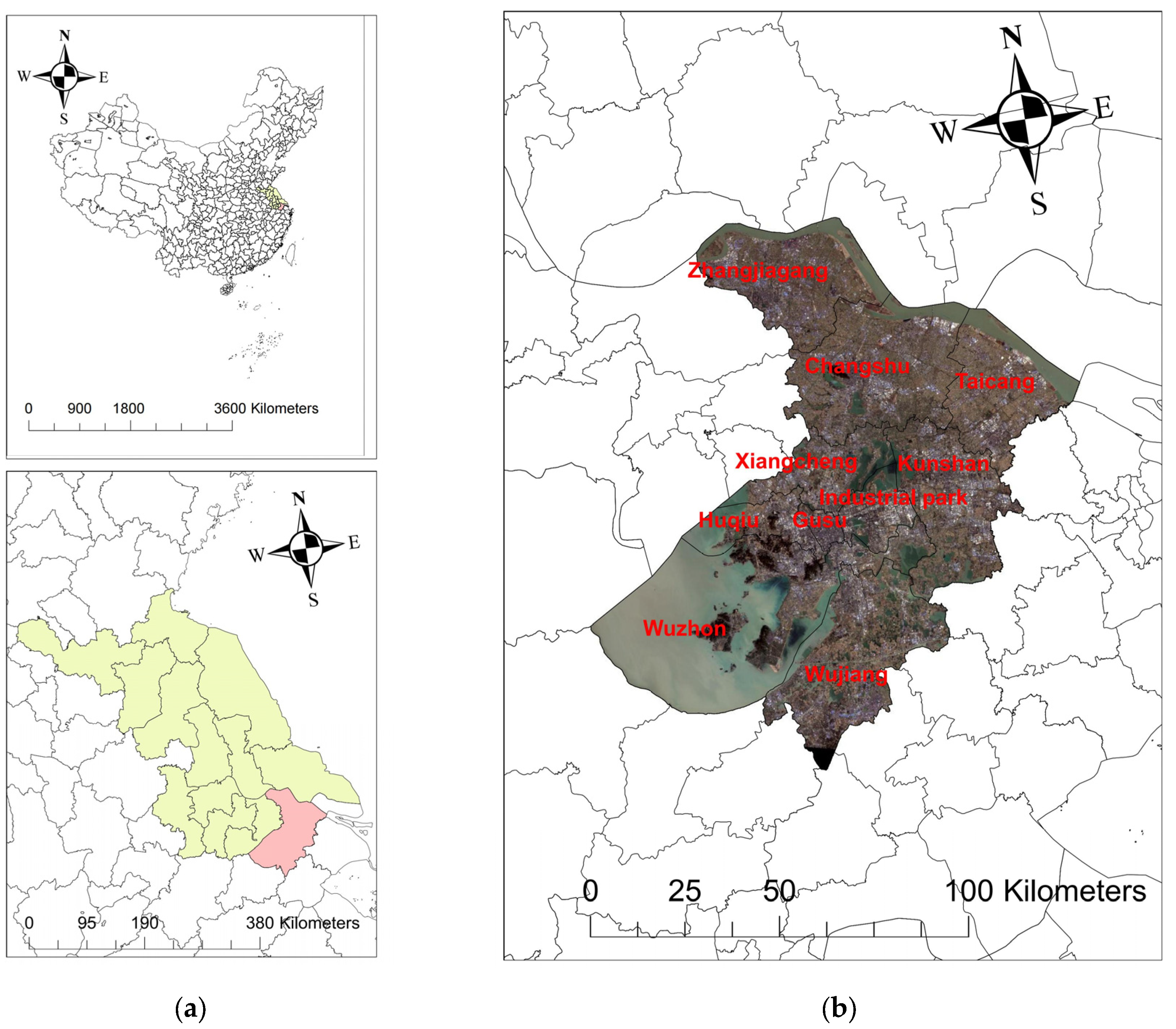


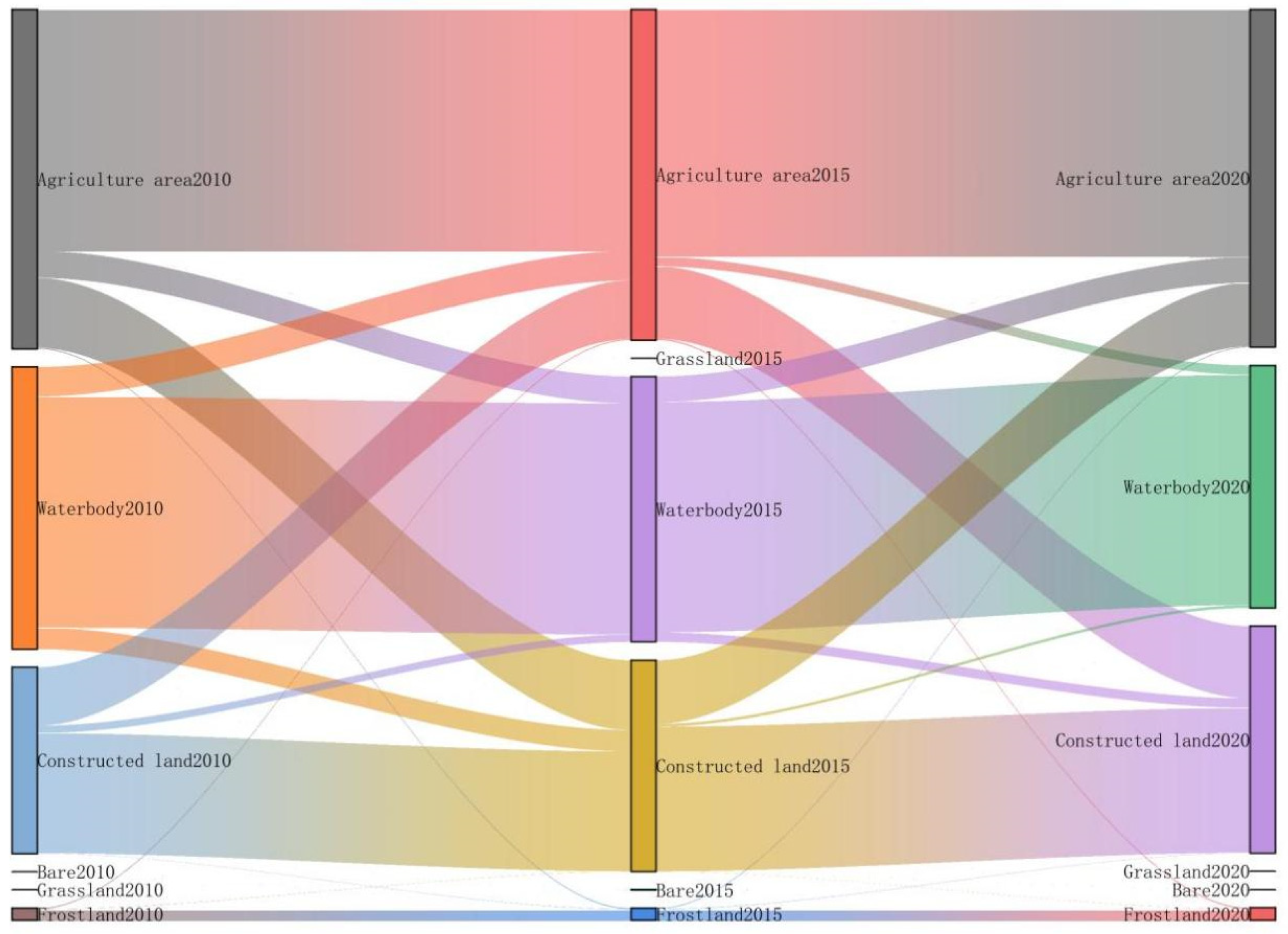

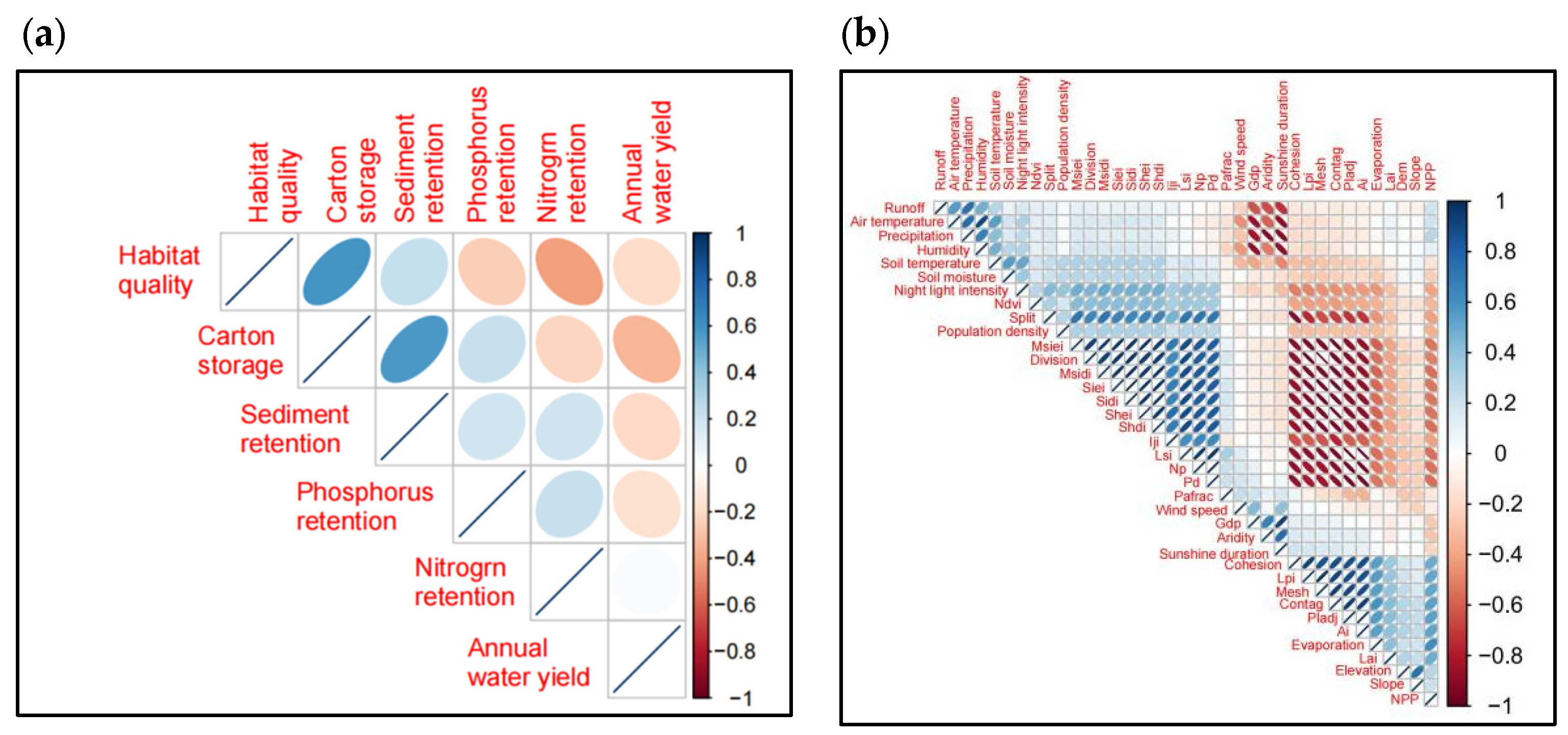
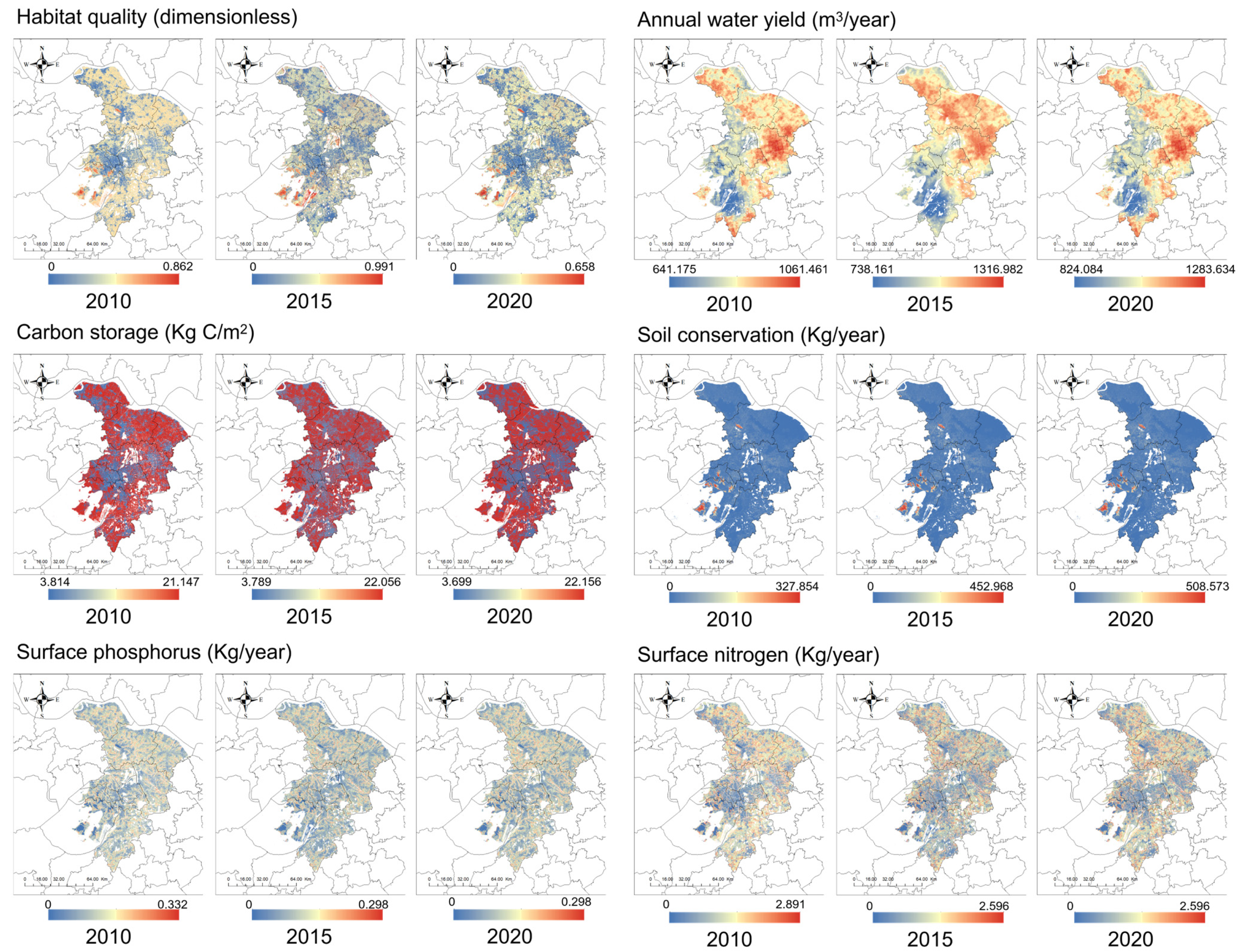
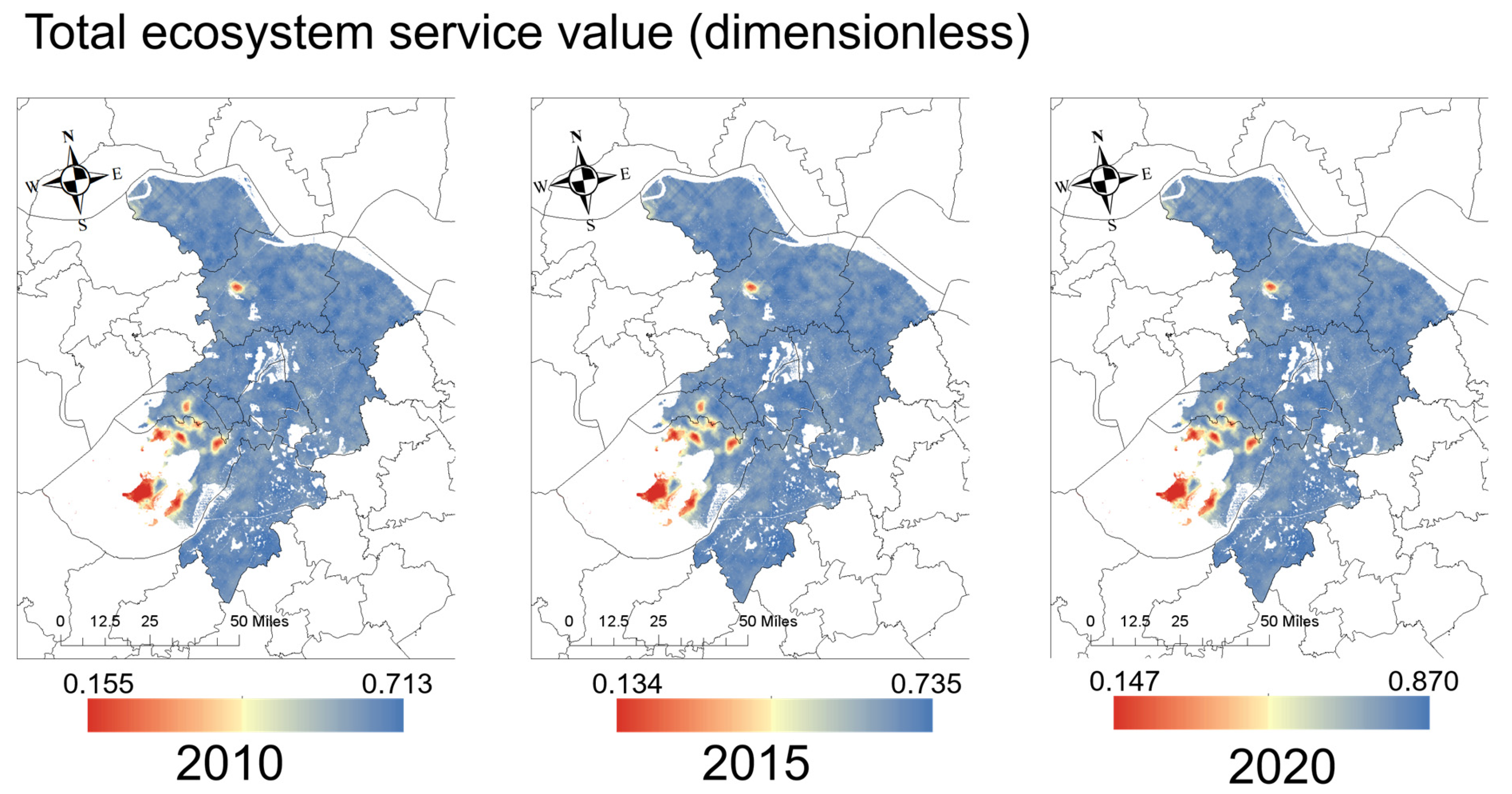
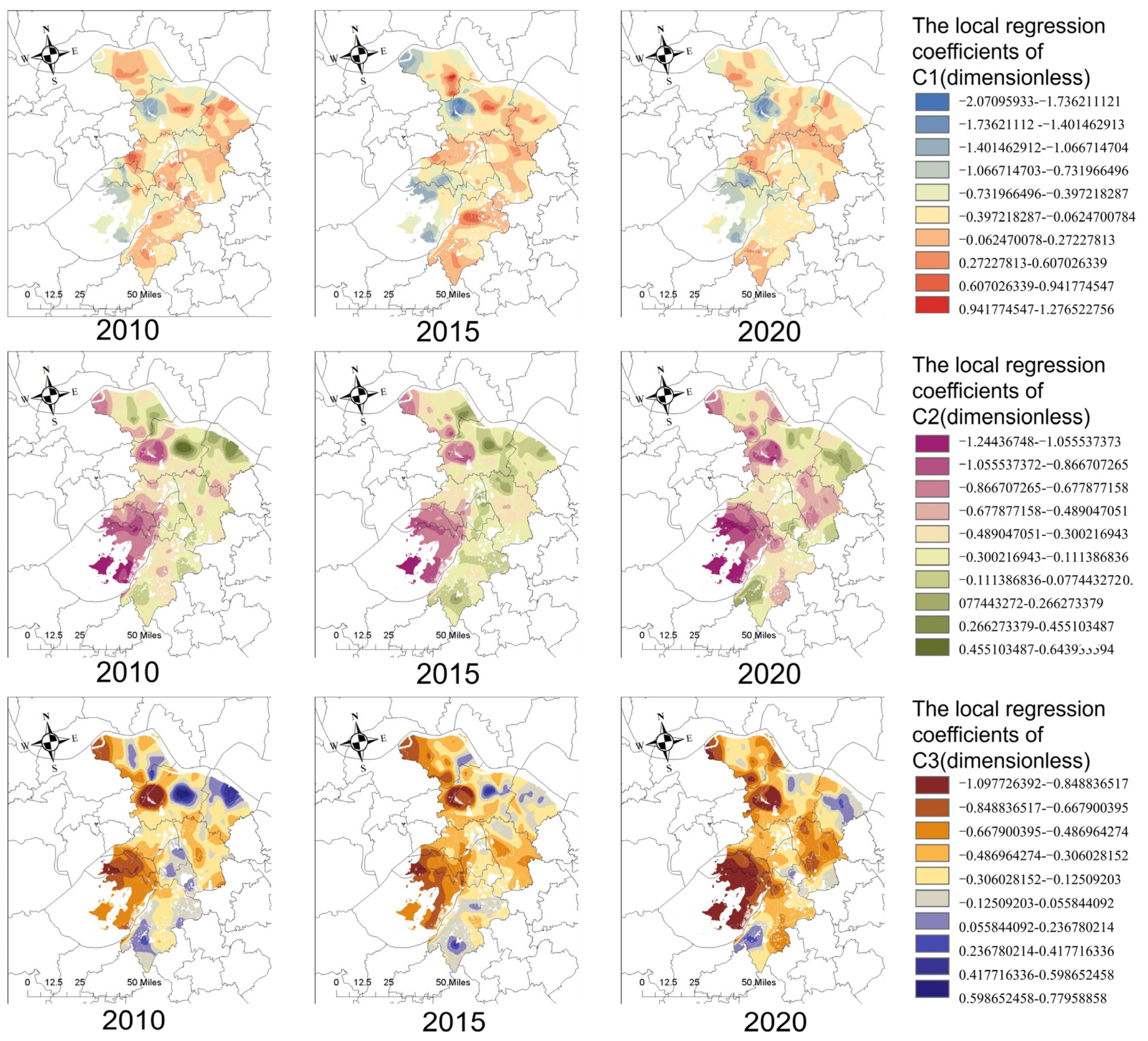
| Data Name | Source |
|---|---|
| Remote Sensing Imagery Data | Landsat 7 Surface Reflectance dataset, United States Geological Survey(USGS). |
| Land Use and Land Cover Change Data (LULC) | computed based on remote sensing imagery data by random forest algorithm based on remote sensing imagery data from Landsat 7 Surface Reflectance dataset, |
| Landscape Pattern Index Data | computed based on LULC maps through Fragstats 4.2 software |
| surface temperature Data | Famine Early Warning Systems Network (FEWS NET) Land Data Assimilation System |
| Humidity Data | Famine Early Warning Systems Network (FEWS NET) Land Data Assimilation System |
| Soil Temperature Data | Famine Early Warning Systems Network (FEWS NET) Land Data Assimilation System |
| Soil Moisture Data | Famine Early Warning Systems Network (FEWS NET) Land Data Assimilation System |
| Net Primary Productivity Data | MODIS Net Primary Production (NPP) CONUS dataset |
| Normalized Difference Vegetation Index | MODIS Vegetation Index 16-Day L3 Global 500 m SIN Grid V006 |
| Sunshine Duration | Geographic Data Sharing Infrastructure, global resources data cloud |
| Leaf Area Index Data | JAXA’s Global Change Observation Mission |
| Runoff Data Data | European Centre for Medium-Range Weather Forecasts |
| Wind speed data | European Centre for Medium-Range Weather Forecasts |
| Precipitation Data | The MOD16A2 Version 6.1 Precipitation |
| Evaporation Data | The MOD16A2 Version 6.1 Evapotranspiration |
| Aridity index Data | computed based on precipitation data and evaporation data |
| Elevation Data | Shuttle Radar Topography Mission (SRTM) |
| Slope Data | computed based on elevation data by ArcGIS Desktop 10.8 |
| Population Distribution Data | Xu Xinliang. China GDP Spatial Distribution Kilometer Grid Dataset. Resource and Environmental Science Data Registration and Publishing System. |
| GDP distribution data | Xu Xinliang. China Population Spatial Distribution Kilometer Grid Dataset. Resource and Environmental Science Data Registration and Publishing System. |
| Soil data for inVEST computation | Harmonized World Soil Database |
| Nighttime Light Intensity Data | National Polar-orbiting Partnership (NPP)’s Visible Infrared Imaging Radiometer Suite |
| Coefficients | |||||||
|---|---|---|---|---|---|---|---|
| Unstandardized Coefficients | Standardized Coefficients | Collinearity Statistics | |||||
| Model | B | Std. Error | Beta | t | Sig. | Tolerance | VIF |
| (Constant) | 1.094 | 0.007 | 150.073 | <0.001 | |||
| Slope | −0.496 | 0.006 | −0.445 | −85.964 | <0.001 | 0.434 | 2.304 |
| Elevation | −0.44 | 0.009 | −0.269 | −51.593 | <0.001 | 0.429 | 2.332 |
| NPP | −0.065 | 0.003 | −0.087 | −20.653 | <0.001 | 0.648 | 1.543 |
| Airtemperature | −0.158 | 0.003 | −0.442 | −49.589 | <0.001 | 0.146 | 6.833 |
| Humidity | 0.162 | 0.003 | 0.435 | 53.388 | <0.001 | 0.175 | 5.726 |
| Ndvi | 0.061 | 0.003 | 0.077 | 20.243 | <0.001 | 0.809 | 1.236 |
| Iji | 0.033 | 0.003 | 0.042 | 10.68 | <0.001 | 0.752 | 1.329 |
| Windspeed | 0.017 | 0.002 | 0.034 | 8.179 | <0.001 | 0.673 | 1.486 |
| Aridity | 0.017 | 0.002 | 0.036 | 7.772 | <0.001 | 0.551 | 1.816 |
| Total Variance Explained | ||||||
|---|---|---|---|---|---|---|
| Component | Initial Eigenvalues | Extraction Sums of Squared Loadingings | ||||
| Total | % of Variance | Cumulative % | Total | % of Variance | Cumulative % | |
| C1 | 2.679 | 29.762 | 29.762 | 2.679 | 29.762 | 29.762 |
| C2 | 2.23 | 24.778 | 54.54 | 2.23 | 24.778 | 54.54 |
| C3 | 1.31 | 14.552 | 69.092 | 1.31 | 14.552 | 69.092 |
| Component Matrix | |||
|---|---|---|---|
| Factors | Component | ||
| 1 | 2 | 3 | |
| Slope | 0.275 | 0.711 | 0.494 |
| Dem | 0.285 | 0.734 | 0.415 |
| NPP | 0.413 | 0.513 | −0.488 |
| Airtemperature | 0.907 | −0.293 | −0.037 |
| Humidity | 0.869 | −0.314 | 0.008 |
| Ndvi | −0.004 | −0.549 | 0.463 |
| Iji | −0.123 | −0.611 | 0.406 |
| Windspeed | −0.576 | −0.018 | −0.412 |
| Aridity | −0.653 | 0.252 | 0.324 |
| Principal Components | Moran’s I | Z Value | p Value | ||||||
|---|---|---|---|---|---|---|---|---|---|
| 2010 | 2015 | 2020 | 2010 | 2015 | 2020 | 2010 | 2015 | 2020 | |
| C1 | 0.971041 | 0.992501 | 0.961092 | 587.5 | 475.6 | 476.9 | 0.000 | 0.000 | 0.000 |
| C2 | 0.988701 | 0.967741 | 0.983406 | 598.2 | 475.7 | 474.7 | 0.000 | 0.000 | 0.000 |
| C3 | 0.978791 | 0.975082 | 0.992171 | 611.5 | 477.2 | 462.2 | 0.000 | 0.000 | 0.000 |
Disclaimer/Publisher’s Note: The statements, opinions and data contained in all publications are solely those of the individual author(s) and contributor(s) and not of MDPI and/or the editor(s). MDPI and/or the editor(s) disclaim responsibility for any injury to people or property resulting from any ideas, methods, instructions or products referred to in the content. |
© 2025 by the authors. Licensee MDPI, Basel, Switzerland. This article is an open access article distributed under the terms and conditions of the Creative Commons Attribution (CC BY) license (https://creativecommons.org/licenses/by/4.0/).
Share and Cite
Shi, T.; Xu, H. Study on Ecosystem Service Values of Urban Green Space Systems in Suzhou City Based on the Extreme Gradient Boosting Geographically Weighted Regression Method: Spatiotemporal Changes, Driving Factors, and Influencing Mechanisms. Land 2025, 14, 564. https://doi.org/10.3390/land14030564
Shi T, Xu H. Study on Ecosystem Service Values of Urban Green Space Systems in Suzhou City Based on the Extreme Gradient Boosting Geographically Weighted Regression Method: Spatiotemporal Changes, Driving Factors, and Influencing Mechanisms. Land. 2025; 14(3):564. https://doi.org/10.3390/land14030564
Chicago/Turabian StyleShi, Tailong, and Hao Xu. 2025. "Study on Ecosystem Service Values of Urban Green Space Systems in Suzhou City Based on the Extreme Gradient Boosting Geographically Weighted Regression Method: Spatiotemporal Changes, Driving Factors, and Influencing Mechanisms" Land 14, no. 3: 564. https://doi.org/10.3390/land14030564
APA StyleShi, T., & Xu, H. (2025). Study on Ecosystem Service Values of Urban Green Space Systems in Suzhou City Based on the Extreme Gradient Boosting Geographically Weighted Regression Method: Spatiotemporal Changes, Driving Factors, and Influencing Mechanisms. Land, 14(3), 564. https://doi.org/10.3390/land14030564







